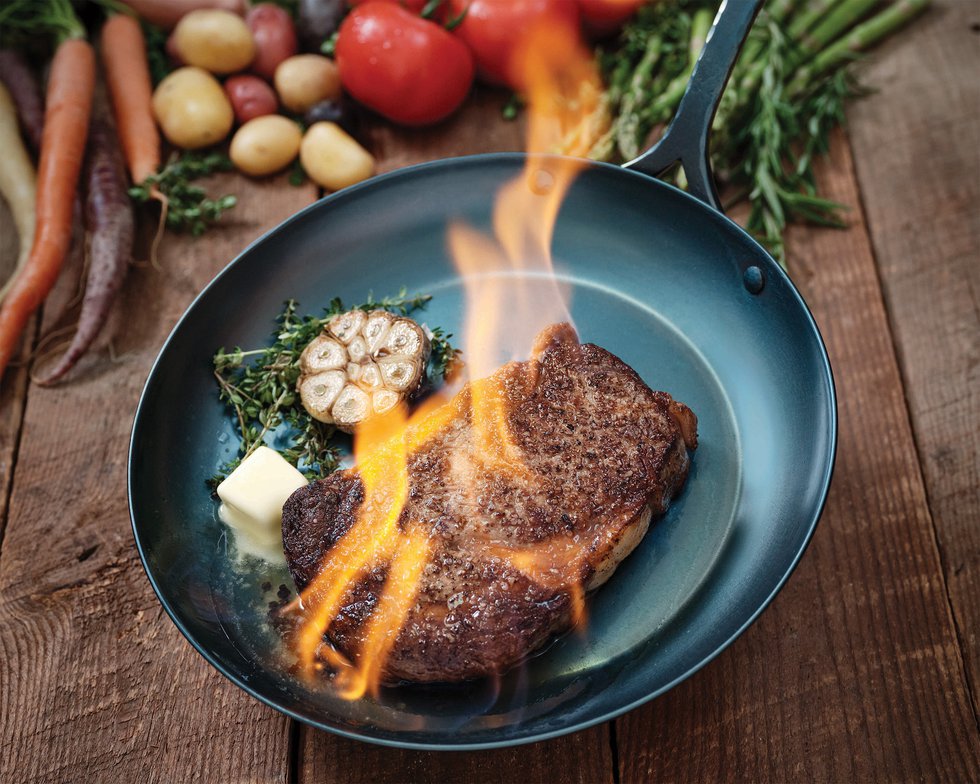Forget iceberg and heavy dressing: Make a tangy, nutrient-rich salad with colorful, fresh greens.

Euro salad garnished with thick-sliced bits of bacon.

Local Asian mix
Local Asian mix garnished with roasted peanuts and rice wine vinaigrette

Continental Salad
Continental salad with sweet dijon vinaigrette
Photography by Kip Dawkins • Food Styling by J Frank • Prop styling by Richard Stone
The farm-to-table trend in American cuisine is all about a return to basics. That’s a good thing, but it hasn’t exactly made life simpler for cooks or shoppers. The sheer variety of produce available to us, especially at farmers’ markets and in specialty gourmet shops, has exploded. Nowhere is this more apparent—and more overwhelming—than with salad greens. Now we are presented with exotica such as tatsoi, bok choy (or is it pak choi? Either!), shungiku, pea shoots, microgreens—in a rainbow of flavor, color and texture. Whatever happened to good old iceberg?
Then again, iceberg lettuce would be an anomaly at a farmers’ market. After all, its raison d’être is its ability to last as long as a couple weeks without melting during its often lengthy trek to the grocery store. The inner leaves of its tightly furled head are almost white because they never photosynthesize—they never reach the sunlight needed for the chemical reaction that creates color and flavor. That’s why iceberg lettuce is so bland, whereas open-leafed plants, with more available surface area, have more color and zing. As a matter of fact, some greens’ flavors are downright hot—spicy. Just try nibbling on a single richly colored mustard leaf by itself. It tastes like a cancer cure, as if it’s burning away bad stuff.
And maybe it is. Biologically, the same compounds that create plant flavor and color also carry important health benefits. The byproducts of photosynthesis include chlorophyll, beta-carotene, vitamins A and C, cancer-preventing phytochemicals—all of them antioxidants. The more intense the color of the plant or fruit, the more concentrated those nutrients. Combine those healthy qualities with vivid flavors, and you get a lot of bang for the buck.
The farm-fresh culinary aesthetic puts the flavors of raw greens front and center. This is a shift from the dressing-driven tradition of salads, in which taste resides in the dressing and the lettuce itself functions simply to offer structure and texture. With these more intense, assertive greens, a drizzle of high-quality olive oil will suffice. Generally, the larger the greens, the more they can stand up to dressing, but less is still more; you want to enhance the bitterness of, say, endive or dandelion with a sweet-salty-garlicky dressing—not drown it.
Highlighting the greens themselves is not a new idea, by any means. Nearly 300 years ago, forward-thinking diarist John Evelyn wrote in his book Acetaria: A Discourse of Sallets, “… in the composure of a sallet, every plant should come in to bear its part, without being overpower’d … but fall into their places, like the notes in music, in which there should be nothing harsh or grating.” (Back then, of course, most folks’ diets consisted largely of meat and potatoes; foliage was for savages.)
Many home cooks perceive salad greens to be fragile, which is why they often opt for sturdier—but less flavorful—iceberg, green leaf and romaine lettuces. But even the most delicate greens, bought soon after picking, will last much, much longer than a head lettuce that’s been on a truck for two weeks. As food writer and “bean queen” Elizabeth Berry once said, “Shipping is a terrible thing to do to vegetables. They probably get jet-lagged, just like people.”
There are a few simple ways to prevent or slow the deterioration of greens. First, choose the freshest you can find—they begin to lose moisture and integrity as soon as they’re picked, so those found at farmers’ markets are invariably best. If you’ve bypassed shipping, then it’s a shame to let greens get mashed when you transport them—simply blowing a puff of air into and then knotting their plastic bag can protect them. Don’t wash them until just before using. When you do, place them in a spinner, dunk them in cold water two or three times, and spin dry—get them as dry as possible so as not to dilute the dressing. Slice the leaves with a sharp knife rather than tearing, which puts pressure on fragile cells. If the greens have wilted, dunking them into an ice water bath can plump them right back up and revive their glow. And don’t dress them until immediately before serving. Oils can permeate the leaves and cause them to collapse. Water-based dressings don’t have this effect but can still weigh the leaves down. Even lemon juice can be hard on tiny microgreens.
Why not mix things up even more? Americans typically start a meal with a salad, whereas Europeans eat salad at the end, as a palate cleanser. There’s nothing effete about it: Some of the pungent compounds in lettuces combine with others to create odorless molecules, literally freshening the breath.
So go forth and try something new. Freshness is always a good thing.
Microgreen and fresh herb salad
THE GREENS
About 1⁄2 cup of each:
radish sprouts
purple radish sprouts
baby ruby Swiss chard
parsley
cilantro
chives
tarragon
GARNISH
apples
THE DRESSING (IF ANY)
olive oil or tangerine oil
Slice, cube or melonball apples and dip in lemon juice (to prevent browning).
Gently toss the greens together and arrange on individual plates. Garnish with apple pieces. Drizzle with a small amount of oil just before serving.
Local Asian Mix
THE GREENS
About 1⁄2 cup of each:
tatsoi
mustard greens
komatsuna
Black Summer komatsuna
bok choy
shungiku
pea shoots
GARNISH
roasted peanuts
THE DRESSING
rice wine vinaigrette
Gently toss the greens together and arrange on individual plates. Garnish with peanuts, and drizzle lightly with the vinaigrette just before serving. Another option: Mist with rice wine vinegar only.
Rice wine vinaigrette
1⁄4 cup rice wine vinegar
1 tablespoon sugar
2 teaspoons lime juice
1 teaspoon Dijon mustard
1⁄4 cup vegetable oil
Mix first four ingredients until sugar is dissolved, then whisk in the vegetable oil.
Continental salad
THE GREENS
About 1⁄2 cup of each:
romaine
red oakleaf
escarole
Bibb lettuce
THE DRESSING
sweet Dijon vinaigrette
Gently toss the greens together and
arrange on individual plates. Drizzle with a small amount of dressing just before serving.
Euro salad
THE GREENS
About 1⁄2 cup of each:
arugula
Italian baby dandelion
French sorrel
bianca frisée
Belgian endive
radicchio
GARNISH
thick-sliced bacon
THE DRESSING
sweet Dijon vinaigrette
Gently toss the greens together and arrange on individual plates, garnish with ham bits, and dress lightly just before serving.
Sweet dijon vinaigrette
1 tablespoon Dijon mustard
2 teaspoons sugar
1 teaspoon salt
several grinds of pepper
2 tablespoons white vinegar
2 tablespoons red wine vinegar
1 small shallot, minced
2 tablespoons extra virgin olive oil
Whisk first seven ingredients together, and add the oil at the end.
All in the Families
THE GREENS FOUND IN TODAY’S SALADS COME FROM A BOTANICAL MELTING POT.
Lettuce family
CHICORY Curly endive, Belgian endive, escarole and radicchio are raised for their bitter flavors, which are carefully managed by growers to keep intensity in check. Belgian endive, for example, is double-grown, the second time in the dark.
ITALIAN DANDELION Bitter! But that’s a good thing.
RED OAKLEAF LETTUCE Mild, with a peppery kick.
ROMAINE Mild and crunchy, in both green and red varieties.
TANGO LETTUCE A tangy, firm butterhead.
TARRAGON A member of the lettuce family but used most often as an herb, with a club-you-over-your-head anise flavor; use sparingly.
Cabbage family
ARUGULA Peppery and elegant.
BOK CHOY/PAK CHOI One of the milder cabbage family members, bok choy’s stalk is sweet with a little kick; leaves are more mild.
KOMATSUNA Known as Japanese mustard spinach, komatsuna’s flavor is less earthy than traditional spinach.
MUSTARD GREENS Spicy! Loses pungency with braising.
TATSOI Also known as “spoon mustard,” for its spoonlike shape; grows in a dark green, loose rosette.
RADISH SPROUTS Almost too pretty to eat; flavor is a distant echo of the spark they’ll have when full-grown.
Herbs
CHERVIL Small leaves with delicately anise-like flavor.
CILANTRO Flavor is fresh and somewhat soapy
FRENCH SORREL Lemony. Disintegrates readily when heated and makes for a great cream sauce.
PARSLEY Lightly floral with a hint of mint.
SHUNGIKU An edible chrysanthemum—its feathery leaves are pungent and floral.
Other
CHIVES An onion family member whose narrow, straplike leaves taste gently oniony.
PEA SHOOTS The leaves of the pea plant, with a lightly sweet, pea-like flavor.
RUBY SWISS CHARD Actually a member of the beet family; raised for its foliage.








